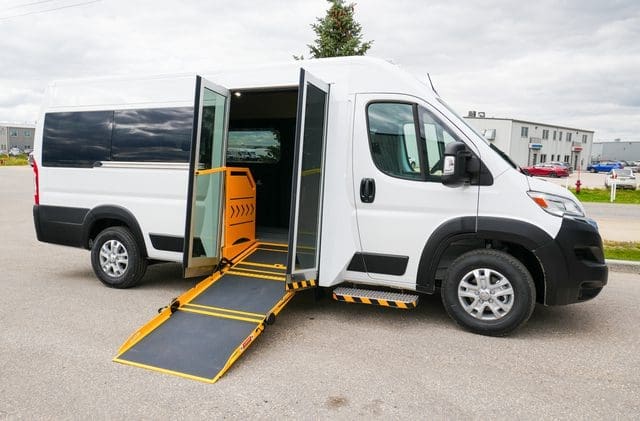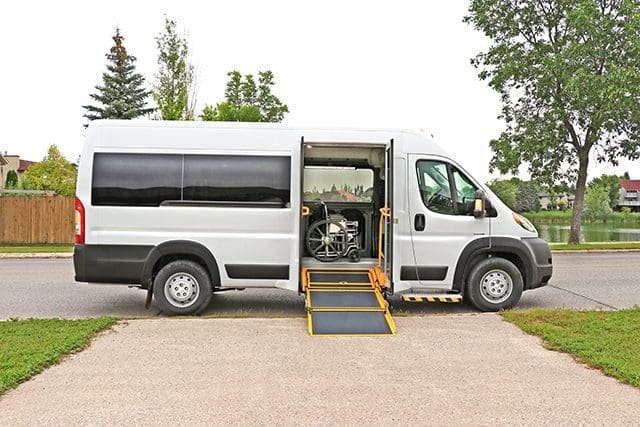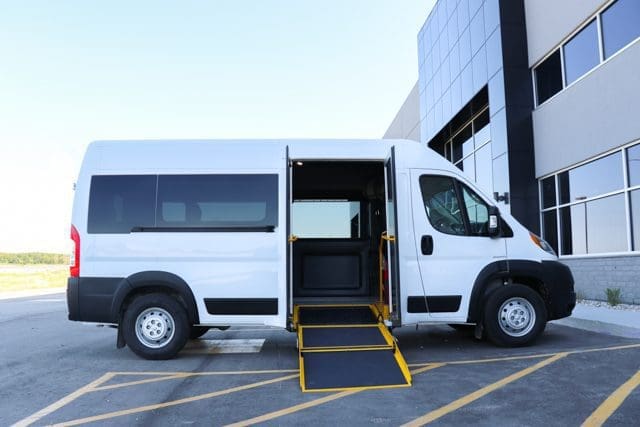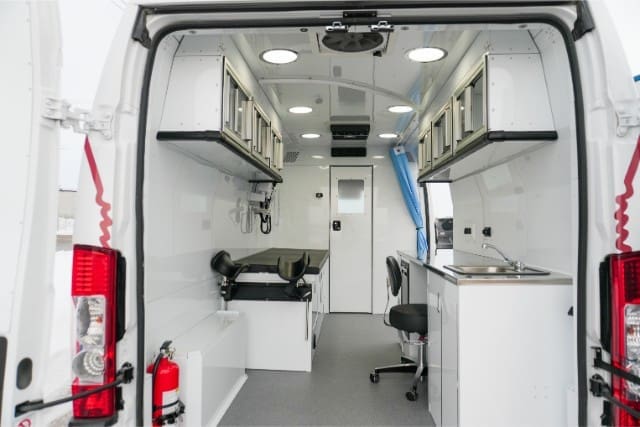Figuring out how to choose a van for handi-transit and urban transit programs can be a confusing ordeal if you don’t know what to look for. When you’re investing big money into one of these vans, you don’t want to be dealing with poor maneuverability, maintenance challenges, and limited accessibility because you made the wrong choice.
Our team at MoveMobility has guided hundreds of organizations like yours in purchasing vans for their hand-transit and urban transit programs. We like to be as transparent as possible when working with our customers. We encourage you to read through this article so you have a better idea of the most important things to keep in mind as you’re trying to decide what van to choose.
In this article, you’ll learn about some of the key features that you should be prioritizing when choosing a vehicle for handi-transit and/or urban transit programs.
8 considerations when choosing vans for handi-transit/urban transit programs

When you’re trying to select a van for your handi-transit or urban transit program, several features should be considered. Let’s take a closer look at those.
1. Ridership
When choosing vans for handi-transit or urban transit programs, a key thing to think about is ridership. This means the number and types of passengers the vehicle can carry at the same time.
Wheelchair users: Check how many wheelchair users the van can comfortably transport. It’s important to have enough space and proper securement to keep passengers safe and comfortable.
Walker users: Consider how well the van accommodates people using walkers. A design that allows easy entry and exit for walker users makes transportation smoother.
Overall capacity: Look at the total number of passengers the van can carry at any time. This includes both wheelchair and walker users, highlighting the need for a flexible and inclusive design.
2. Day-to-day operations
You also need to think about your day-to-day operations. This means figuring out how your organization will be using the van:
Regular routes: Some vans follow a fixed route like a regular bus. They stop at specific places at certain times. This is great for people who have a routine and like to plan their trips.
On-demand service: Other vans don’t follow a set route. They go where people need them when they need them. This is ideal for those who want a ride right when they decide to go somewhere.
Taxi partnerships: Sometimes, organizations team up with a taxi company to run the van. It’s like a teamwork approach to provide rides to more people. Try to decide if your organization will be taking this route with its daily operations.
3. Geographical territory and environmental factors
It’s important to consider the geographical territory the van needs to cover. This means understanding how much ground it has to travel to help people across the country.
City or rural: Consider if the van will primarily serve cities or rural areas. In cities, there will most likely be more stops and shorter distances. Rural areas typically require longer journeys between stops. Environmental factors also differ between urban and rural areas. Vans must be adaptable to various terrains, from city streets to rugged rural paths.
Province to province: If the van needs to travel between provinces, it must be equipped for longer trips. Ensuring comfort and accessibility during extended journeys is essential.
Weather conditions: Think about the different weather conditions in Canada. The van should be prepared to handle various climates, ensuring safe transportation in rain, snow, or sunshine. That means a high-capacity heating and cooling system is essential.
As you think about these things, you’ll be able to tailor the van’s capabilities to the specific geographical needs of Canada. That means you’ll be prepared to cover the diverse and vast distances to provide accessible transit services to your clients across the country.
4. Budget
Your budget is another big thing to think about. This means understanding both the initial costs and the ongoing expenses. Let’s break it down for your Canadian operations.
Capital costs: First, you need to look at how much it costs to get the vans in the beginning. You should make sure the upfront money you’re spending fits your budget.
Operational costs: Then, think about the day-to-day costs like fuel, maintenance, and staff. Vans that use fuel wisely and don’t need a lot of fixing can help you save money over time.
Regional variances: Remember, costs are different across Canada. Things like fuel prices or how much it costs to hire workers change based on where you are.
Planning for the future: It’s not just about what you spend now. You want a budget that works today and also in the future. This means thinking ahead and being ready for any changes in costs.
Carefully managing both the money you spend at the start and what you use every day ensures your Canadian transit operations are successful and can keep going for the foreseeable future.
5. Driver pool availability
The next consideration to keep in mind is the availability of a driver pool. There are a couple of things to think about when it comes to your driver pool.
Qualified drivers: You need to ensure there are enough drivers with the right qualifications to operate the vans. This involves considering the availability of skilled individuals who can handle the unique needs of accessible transit.
Geographical distribution: Recognize that driver availability may vary across different regions of Canada. Assess the pool of qualified drivers in the specific areas where the vans will operate.
Training programs: Consider partnering with or investing in training programs to expand the pool of skilled drivers. This addresses current needs and contributes to the development of a sustainable and well-trained workforce.
Adapting to demand: Assess the flexibility of the driver pool to meet varying demands. Having a pool that can adapt to peak times or unexpected changes ensures consistent and reliable transit services. For example, if you suddenly get 5 client bookings in a row, your drivers should be flexible enough to deal with this in their schedules.
6. Wheelchair lift or ramp in your handi-transit van

Decide if your handi-transit or urban transit program requires your wheelchair to have a lift or a ramp.
Wheelchair lifts: These devices lift wheelchairs and passengers into the van. Wheelchair lifts are straightforward for drivers to use. The powered lifts have a 1,000-weight capacity and can lift the biggest wheelchairs on the market.
Ramps: Ramps are like slopes that let wheelchair users roll onto the van easily. All it takes is a simple push of a button to deploy them and both wheelchair users and clients with walkers can access the van on them.
Cycle time: It’s important to consider the cycle time for each option. Wheelchair lifts, while effective, can be slower compared to the speedy deployment of power ramps. Powered ramps provide faster boarding and also cause the least strain on drivers.
Read our article on ramps vs. lifts for everything you need to know when deciding between these two options.
7. Quality of handi-transit/urban transit service
You need to think about the quality of service you’ll be providing your handi-transit and urban transit clients.
Full control: If you want to be in charge of how good the service and experience is for your clients, doing everything in-house is the way to go. This means taking care of every part of the operation to make sure it’s excellent.
Running things in-house lets you keep things consistent. This means every ride, no matter where it is, stays at a high standard, making customers happy.
Changing and Improving: With full control, you can change and make things better based on feedback from your clients. Being able to adapt is really important to meet the different needs of transportation in Canada.
8. Convenience
How convenient and straightforward do you want your program to be? This all boils down to whether you want to run and manage the handi-transit or urban transit program yourself or just pay someone else to take care of everything.
In-house management: If you like being in charge, running the service in-house means you get to control everything, as we mentioned earlier. It’s like steering the ship to make sure the program matches your ideas and helps Canadian communities as it should.
Outsourcing: On the other hand, if you want things to be simpler, you can just cut a cheque and let someone else handle the program. This is easier for you, but you have to trust that the other folks will do a good job.
Your next steps with MoveMobility

You landed on this article looking for more information on how to choose a van for your handi-transit or urban transit programs.
Now that you know about these 8 considerations to keep in mind during your research, we have 2 other articles we want you to look at to steer you in the right direction. First, check out our article on how long it takes to get a wheelchair van. This article will give you a better idea of how long you can expect to wait to receive your van.
After that, you should read through our article on how much it costs to own a wheelchair van for 1 year. You’ll learn about fuel costs, insurance fees, the cost of annual lift and ramp inspections, and engine oil change costs.







